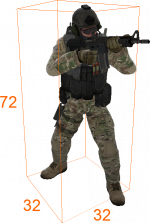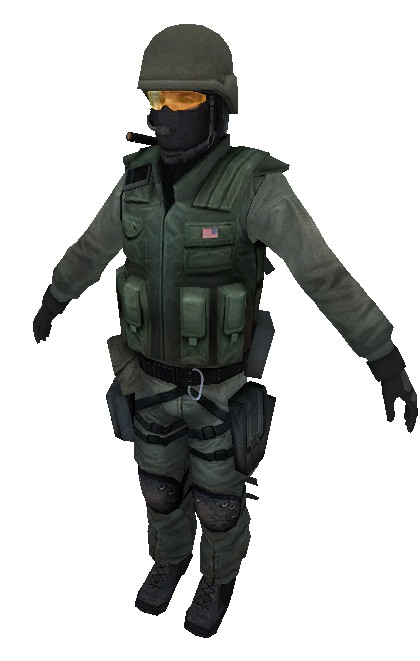info_player_(counter)terrorist
(Redirected from Info player terrorist)
This page documents information about a game,  Counter-Strike: Global Offensive, that is no longer available for purchase or download digitally.
Counter-Strike: Global Offensive, that is no longer available for purchase or download digitally.
It is covered here for historical and technical reference.
It is covered here for historical and technical reference.
info_player_terrorist and info_player_counterterrorist are point entities available in the following ![]() Source engine games:
Source engine games: ![]() Counter-Strike: Source,
Counter-Strike: Source, ![]() Counter-Strike: Global Offensive and
Counter-Strike: Global Offensive and ![]() Counter-Strike 2.
Counter-Strike 2.
These entities are spawn points for either Terrorists or Counter-Terrorists.
At least one of each should be placed for each team member. This may result in the Both Teams are Full error.
- at least 16 units above the ground,
- more than 32 units away from each other,
- more than 16 units away from surrounding walls and
- not intersecting with any solid geometry,
otherwise the spawn point can become invalid, effectively behaving as if it didn't exist.
Standard maps use between 16 and 32 spawn points.[Why?]
Invalid terrorist spawnpoint at (<x>,<y>,<z>). These lines can easily be found in the console using con_filter_enable 2 and con_filter_text spawnpoint.Spawn Priority (int) keyvalue for all other spawn points. The former are used first, latter are only used if needed.- On a new round, its properties including its position will intentionally not reset. You can use logic_auto to emulate resetting it.
- Killing it removes it forever, as it is not respawned on a new round.
- It cannot be spawned with a point_template.
- Parenting this with non preserved entities may have undesirable effects.
Contents
Porting between  Half-Life 2 and
Half-Life 2 and  Half-Life 2: Deathmatch
Half-Life 2: Deathmatch
Unlike ![]() Half-Life 2 and
Half-Life 2 and ![]() Half-Life 2: Deathmatch spawn point entities,
Half-Life 2: Deathmatch spawn point entities, ![]() Counter-Strike: Source spawn point entities will intersect the ground if not placed a couple of units above it.
Counter-Strike: Source spawn point entities will intersect the ground if not placed a couple of units above it.
Games
Keyvalues
- Spawn priority
(priority)<integer> (only in )
) - Determines which spawn points get used first. Smaller numbers are used before larger numbers.
- Enabled by default?
(enabled)<boolean> (only in )
) - Should this spawn be enabled by default?
Base:
- Parent
(parentname)<targetname> - Maintain the same initial offset to this entity. An attachment point can also be used if separated by a comma at the end. (
parentname [targetname],[attachment]) Tip:Entities transition to the next map with their parents
Tip:Entities transition to the next map with their parents Tip:
Tip:phys_constraintcan be used as a workaround if parenting fails.
- Origin (X Y Z)
(origin)<coordinates> - The position of this entity's center in the world. Rotating entities typically rotate around their origin.
 Note:Hammer does not move the entities accordingly only in the editor.
Note:Hammer does not move the entities accordingly only in the editor.
- Pitch Yaw Roll (X Y Z)
(angles)<angle> - This entity's orientation in the world. Pitch is rotation around the Y axis, yaw is the rotation around the Z axis, roll is the rotation around the X axis.
 Note:This works on brush entities, although Hammer doesn't show the new angles.
Note:This works on brush entities, although Hammer doesn't show the new angles.
- Classname
(classname)<string> !FGD - Determines the characteristics of the entity before it spawns.
 Tip:Changing this on runtime still has use, like making matching an entry in S_PreserveEnts will persist the entity on new rounds!
Tip:Changing this on runtime still has use, like making matching an entry in S_PreserveEnts will persist the entity on new rounds!
- Flags
(spawnflags)<flags> !FGD - Toggles exclusive features of an entity, its specific number is determined by the combination of flags added.
- Effects
(effects)<flags> !FGD - Combination of effect flags to use.
- Entity Scripts
(vscripts)<scriptlist> (in all games since ) (also in
) (also in  )
) - Space delimited list of VScript files (without file extension) that are executed after all entities have spawned. The scripts are all executed in the same script scope, later ones overwriting any identical variables and functions. Scripts executed on the worldspawn entity will be placed in root scope.
- Think function
(thinkfunction)<string> (in all games since ) (also in
) (also in  )
) - Name of the function within this entity's script that'll be called automatically every 100 milliseconds, or a user-defined interval if the function returns a number. Avoid expensive operations in this function, as it may cause performance problems.
- Lag Compensation
(LagCompensate)<boolean> (in all games since ) !FGD
) !FGD - Set to Yes to lag compensate this entity. Should be used very sparingly!
- Is Automatic-Aim Target
(is_autoaim_target)<boolean> (in all games since ) !FGD
) !FGD - If set to 1, this entity will slow down aiming movement for consoles and joystick controllers when the entity is under the crosshairs.
Inputs
Base:
AddContext<string>- Adds to the entity's list of response contexts. See Context.
AddOutput<string>- Assigns a new keyvalue/output on this entity. For keyvalues, some rely on extra necessary code to be ran and won't work if its simply just changed through this input. There is a strict format that must be followed:
// Format of changing KeyValues: "AddOutput [key] [value]"
//// Raw text:
"OnUser1" "!self,AddOutput,targetname new_name"
// Format of adding an Output: "AddOutput {targetname}:{inputname}:{parameter}:{delay}:{max times to fire, -1 means infinite}"
//// Raw text:
"OnUser1" "!self,AddOutput,OnUser1:SetParent:!activator:0.0:-1"
// Arguments can be left blank, but the empty blank should still be contained.
//// Raw text:
"OnUser1" "!self,AddOutput,OnUser1:ClearParent::0.0:-1"
|
ClearContext- Removes all contexts from this entity's list.
ClearParent- Removes this entity from the the movement hierarchy, leaving it free to move independently.
FireUser1toFireUser4- Fires the respective
OnUseroutputs; see User Inputs and Outputs.
Kill- Removes this entity and any entities parented to it from the world.
KillHierarchy- Functions the same as
Kill, although this entity and any entities parented to it are killed on the same frame, being marginally faster thanKillinput.
RemoveContext<string>- Remove a context from this entity's list. The name should match the key of an existing context.
SetParent<string>- Move with this entity. See Entity Hierarchy (parenting).
SetParentAttachment<string>- Change this entity to attach to a specific attachment point on its parent. The entity will teleport so that the position of its root bone matches that of the attachment. Entities must be parented before being sent this input.
SetParentAttachmentMaintainOffset<string>- As above, but without teleporting. The entity retains its position relative to the attachment at the time of the input being received.
DispatchResponse<string> !FGD- Dispatches a response to the entity. See Response and Concept.
DispatchEffect<string> (removed since ) !FGD
) !FGD- Dispatches a special effect from the entity's origin; See also List of Client Effects. Replaced by the particle system since
 .
.
RunScriptFile<script> (in all games since ) (also in
) (also in  )
)- Execute a VScript file from disk, without file extension. The script contents are merged with the script scope of the receiving entity.
RunScriptCode<string> (in all games since ) (also in
) (also in  )
)- Execute a string of VScript source code in the scope of the entity receiving the input. String quotation may be needed when fired via console.
 Bug:In Hammer, using string arguments will corrupt the VMF file's structure, making the file unviewable for the next Hammer session.
Bug:In Hammer, using string arguments will corrupt the VMF file's structure, making the file unviewable for the next Hammer session. Fix:Remove the string argument manually with a text editor.
Fix:Remove the string argument manually with a text editor.
CallScriptFunction<string> (in all games since ) (also in
) (also in  ) !FGD
) !FGD- Calls a VScript function defined in the scope of the receiving entity.
TerminateScriptScope(only in ) !FGD
) !FGD- Destroys the script scope of the receving entity.
SetLocalOrigin<coordinates> (in all games since ) !FGD
) !FGD- Send this entity to a spot in the map. If the entity is parented to something, it will be offset from the parent by this amount.
Outputs
Base:
OnUser1toOnUser4- These outputs each fire in response to the firing of the like-numbered
FireUser1toFireUser4Input; see User Inputs and Outputs.


